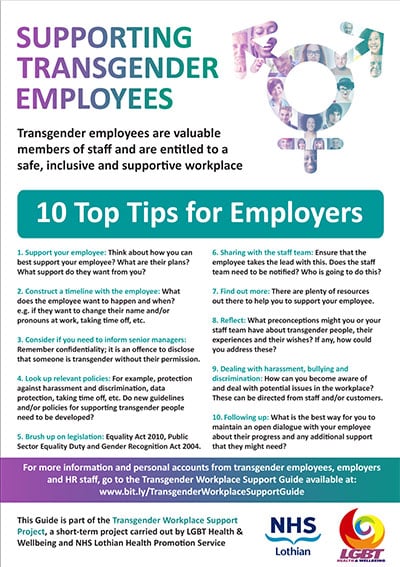NHS Lothian (NHSL) developed a number of initiatives to support Transgender employees at work
The following article describes a guide that was produced for transgender people in the workplace, their employers and managers and the LGBT Staff and Allies Network which, as well as being a social network has a role in the organisation’s Equality and Diversity Steering Group.
In 2015, discussions between NHS Lothian Health Promotion Service (HPS) and LGBT Health and Wellbeing (LGBT Health) staff identified a lack of guidance for employers on how best to support Transgender people in the workplace.
Issues associated with gender identity and transition (the process of modifying the appearance of an individual’s gender identity) are complex and can be difficult for both employees and employers; however, little research appeared to have been conducted in the UK into how this process could be supported.
Evidence from the US suggested that employment practices which create a supportive environment for transgender employees, can help the transitioning employee to avoid experiencing stress and alienation and keep their jobs with the organisation.
The Transgender Workplace Support Guide
NHSL HPS funded the development of a Transgender Workplace Support Guide which involved:
- Conducting a consultation exercise with transgender people and managers/employers who have experienced challenges and positives while as an employee or while supporting a trans person at work.
- Designing and producing information to guide managers, employers and employees through the process of supporting someone undergoing gender transition.
A Development Worker was recruited to lead on the project, conduct interviews and analyse the data. A Steering Group was established to guide the process and to act as a sounding board for the development of the guidance. The Steering Group comprised representatives from the transgender community, LGBT Health staff and the HPS. There was provision to co-opt others to the group at different points in time when their expertise may have been of value.
The guide provides advice on a range of issues that have to be considered when an employee decides they wish to change their gender identity including: communicating with co-workers and clients about changes; modifying personnel documents at the appropriate time; and other issues such as use of toilet facilities and dress codes. Guidance is also given on how to adjust to the changed dynamics in interpersonal relations when a colleague or employee changes identity.
The guide was produced in hard copy and as an on-line resource. Additional resources created to compliment the Guide included: a leaflet for Transgender employees; a Poster to be displayed on staff notice boards and Top Tips for employees, employers/managers and HR staff.
10 Top Tips for Transgender Employees
10 Top Tips for Transgender Employees
- Sharing with someone: Consider who, and if, you would like to share your gender identity or gender history with and what you would like them to support you with.
- Your personal timeline: If you want to ‘come out’ at work or transition, what will your transition/coming out process look like? Will you need time off for anything?
- Talk to your employer: Your employer has a responsibility for being mindful of your health and wellbeing. Would it benefit you to share with your employer? What do you want support with? Would you like to bring someone along to this meeting?
- Construct a timeline with your employer: What do you want to happen and when? e.g. if you want to change your name and/or pronouns at work, taking time off, etc.
- Would you like to apply for a Gender Recognition Certificate? Whether or not you have one can affect things like your pensions and benefits.
- Look up your organisation’s policies: For example, protection against harassment and discrimination, data protection, and taking time off.
- Find out about relevant and supportive legislation: Equality Act 2010, Public Sector Equality Duty and Gender Recognition Act 2004
- Sharing with the staff team: Do you want everyone/just some/no one to know? Who is going to do this and how?
- Get support: Do you have all the support you need? Consider other places where you can get support from (e.g. trades unions, LGBT organisations, occupational health).
- Open dialogue: Would you like to maintain an open dialogue with your employer about your gender identity? What is the best way of doing this?
We had excellent support in pulling the work together by our Development Worker; however, we underestimated the time it would take to create and edit the report so, in retrospect, we would have employed them for longer.
Since that time there has been a significant increase within the trans community, of community members wanting to lead their own projects and develop their own resources: if we were to do this again we would have more leadership from the trans community on the content and design of the resource.
The guide was widely distributed through the Health Promotion Resource Centre’s on-line catalogue and the networks of LGBT Health and Wellbeing (see below for links). A banner was designed for the NHS Lothian Website and communication was included in the NHS Lothian staff newsletter. Although the hard copies are now out of print, resources can still be accessed from the link below.
Training and awareness raising
One-hour Transgender workshops and half day Transgender Awareness training sessions were designed to raise awareness of transgender issues and help promote good working practice. These sessions are available for all NHSL staff through the HPS in collaboration with the Scottish Trans Alliance.
Staff support network
The LGBT+ Staff and Allies Network (the Network) which was started at grass roots level has been fully supported by NHS Lothian. Network Leads are now members of NHS Lothian’s Equality and Diversity steering committee. The Network is open to all LGBT staff and allies, and organises social events and training opportunities. The Network has its own intranet pages and social media accounts. The rainbow lanyards and NHS Scotland Pride badge are supported by NHS Lothian and are a visible way of showing support and inclusion to LGBT patients and staff.
NHS Lothian had a presence at the last Edinburgh Pride in 2019, including a stall in the health and wellbeing area.
Recent LGBT staff ‘Spotlight On’ features have been displayed on the NHS Lothian (@NHS_Lothian) and NHS Lothian LGBT+ Staff Network (@lgbt_nhs) Twitter pages, in support of Trans Day of Visibility (31 March 2021) and Pride Month (June 2021).
Top tips for Employers
10 Top Tips for Employers
- Support your employee: Think about how you can best support your employee? What are their plans? What support do they want from you?
- Construct a timeline with the employee: What does the employee want to happen and when? eg. if they want to change their name and/or pronouns at work, taking time off, etc.
- Consider if you need to inform senior managers: Remember confidentiality; it is an offence to disclose that someone is transgender without their permission.
- Look up relevant policies: For example, protection against harassment and discrimination, data protection, taking time off, etc. Do new guidelines and/or policies for supporting transgender people need to be developed?
- Brush up on legislation: Equality Act 2010, Public Sector Equality Duty and Gender Recognition Act 2004.
- Sharing with the staff team: Ensure that the employee takes the lead with this. Does the staff team need to be notified? Whio is going to do this?
- Find our more: There are plenty of resources out there to help you to support your employee.
- Reflect: What preconceptions might you or your staff team have about transgender people, their experiences and their wishes? If any, how could you address these?
- Dealing with harassment, bullying and discrimination: How can you become aware of and deal with potential issues in the workplace? These can be directed from staff/or customers.
- Following up: What is the best way for you to maintain an open dialogue with your employee about their progress and any additional support that they might need?
Related content
- Published:
- 12/07/2021
- Resources
- Learning material
- Subcategory:
- Case study, Information and support
- Audience
- Employers


